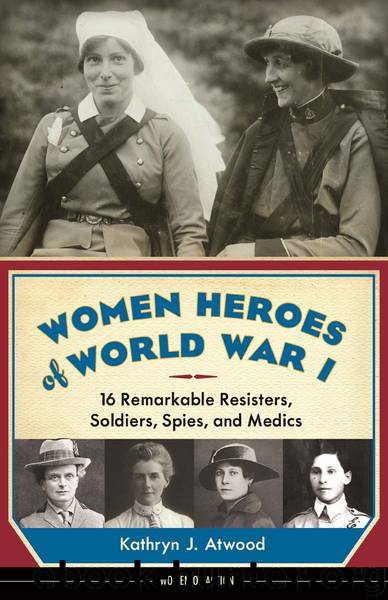Women Heroes of World War I by Kathryn J. Atwood

Author:Kathryn J. Atwood
Language: eng
Format: epub, azw3
Publisher: Chicago Review Press
Published: 2014-07-13T16:00:00+00:00
LEARN MORE
Contacts and Contrasts by Helena Gleichen (John Murray, 1940; reprint Mansion Field, 2013).
The White War: Life and Death on the Italian Front, 1915–1919 by Mark Thompson (Faber and Faber, 2008).
SHIRLEY MILLARD
Nurse Armed with Enthusiasm
“Banners streamed in my blood. Drums beat in my brain. Bugles sounded in my ears. I wanted to go overseas.”
—Shirley Millard
To young Shirley Millard in March 1918, New York City seemed to be the most exciting place on earth. The United States was on the verge of sending large quantities of trained troops overseas, and young men in uniform swarmed the city, marching in parades and crowding into the Red Cross centers and canteens.
Why had the United States joined the war? President Wood-row Wilson had been determined since the war’s outbreak to stay neutral. In fact, his 1916 reelection slogan had been, “He kept us out of the war.”
A group of American volunteer nurses on their way to France.
Marion McCune Rice Collection © Steve Hooper
But Germany, having been pressured by the United States in 1915 to stop its submarine warfare against nonmilitary vessels, now thought that using U-boats to sink all ships traveling in and out of British ports might be the quickest way to win the war. When unrestricted submarine warfare officially resumed in February 1917 the Germans sunk an American ship, and the United States broke off diplomatic relations with Germany. Soon afterward, the American public discovered the existence of the Zimmerman Telegram, a communication sent to the Mexican government from a German official in which he promised to give US territory to Mexico if Mexico would join the Central Powers. When three more American ships were sunk by German submarines in March 1917, President Wilson could no longer avoid a decision to join the Allies. On the evening of April 2, 1917, he gave a speech to Congress saying that war with Germany was necessary, not because the United States wanted more territory like most of the European combatants but because “the world must be made safe for democracy.” Congress agreed, and on April 6, 1917, the United States was officially at war with Germany.
However, at the time, the United States had a very small army, especially in comparison with Germany’s, and it took some time for the United States to prepare enough troops to send across the Atlantic.
So nearly a year later, in March 1918, many of the young men Shirley personally knew were either being trained, waiting to leave for Europe from New York, or already in France. Everywhere she went, Shirley heard patriotic, pro-war songs being sung and played: “Over There,” “It’s a Long Way to Tipperary,” and “Roses of Picardy.” Shirley became desperate to go overseas.
Download
Women Heroes of World War I by Kathryn J. Atwood.azw3
This site does not store any files on its server. We only index and link to content provided by other sites. Please contact the content providers to delete copyright contents if any and email us, we'll remove relevant links or contents immediately.
Pale Blue Dot by Carl Sagan(4027)
Pocahontas by Joseph Bruchac(3734)
Unfiltered by Lily Collins(3617)
Cracking the GRE Premium Edition with 6 Practice Tests, 2015 (Graduate School Test Preparation) by Princeton Review(3609)
The Emotionary: A Dictionary of Words That Don't Exist for Feelings That Do by Eden Sher(2960)
Factfulness_Ten Reasons We're Wrong About the World_and Why Things Are Better Than You Think by Hans Rosling(2763)
The President Has Been Shot!": The Assassination of John F. Kennedy by Swanson James L(2740)
The Daily Stoic by Holiday Ryan & Hanselman Stephen(2719)
Rogue Trader by Leeson Nick(2484)
Sapiens and Homo Deus by Yuval Noah Harari(2429)
Gettysburg by Iain C. Martin(2333)
The Rape Of Nanking by Iris Chang(2332)
Almost Adulting by Arden Rose(2304)
500 Must-Know AP Microeconomics/Macroeconomics Questions(2247)
The Plant Paradox by Dr. Steven R. Gundry M.D(2056)
In the Woods by Tana French(2015)
Make by Mike Westerfield(1975)
The 48 laws of power by Robert Greene & Joost Elffers(1947)
The 7 Habits of Highly Effective People: Powerful Lessons in Personal Change (25th Anniversary Edition) by Covey Stephen R(1845)
